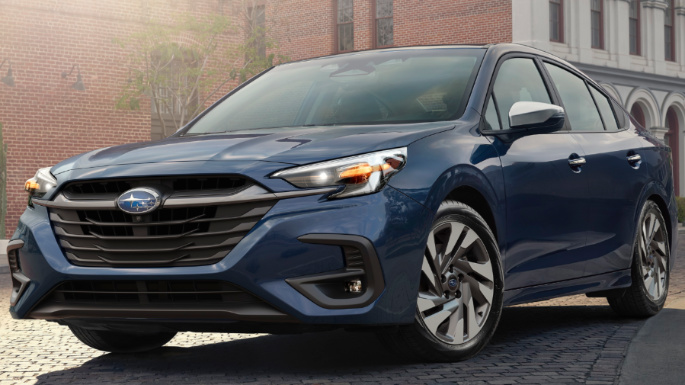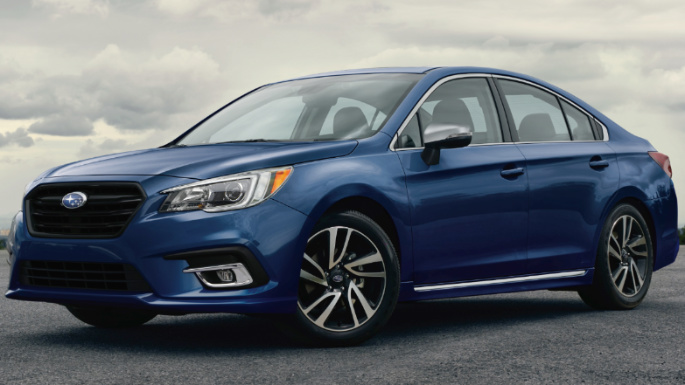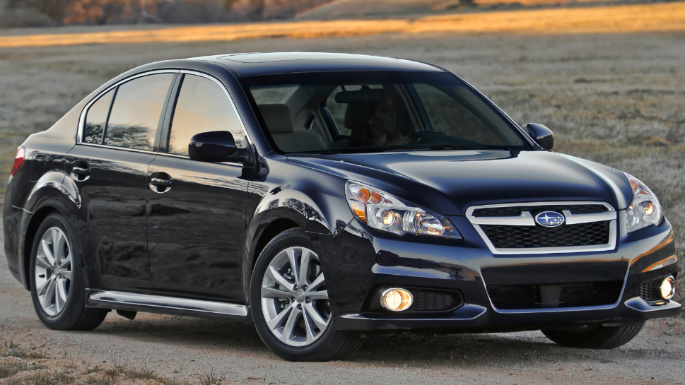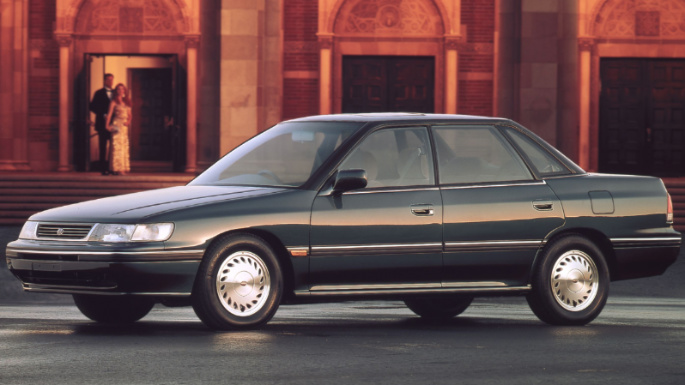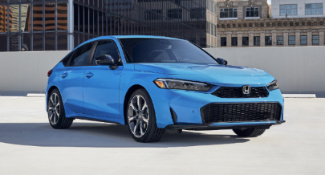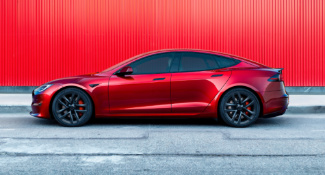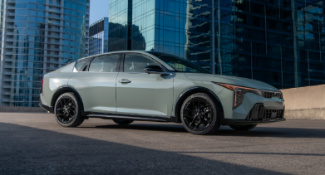The Subaru Legacy is a midsize sedan that currently rivals the Toyota Camry, the Honda Accord, the Nissan Altima, the Hyundai Sonata, and the Kia K5. Thanks to a waning interest in sedans in the North American market, Subaru has announced that the Legacy will be discontinued after the 2025 model year.
The Legacy has always been a unique offering. Although it is known and loved by its buyers for Subaru’s full-time Symmetrical All-Wheel Drive system, the first 1990 Subaru Legacy was front-wheel drive as standard. It was still available with all-wheel drive and came in either station wagon or four-door sedan body styles.
A more adventure-focused version of the Legacy, called the Legacy Outback, debuted in North America for the 2000 model year, eventually becoming its own model in 2010 and taking the station wagon body style with it. At various times since, it has served as both an alternative and a counterpart to the Impreza and the Forester, only recently becoming more of a true roadgoing family sedan focused on comfort and less on adventure.
2020 - 2025 Subaru Legacy (7th Generation)
The Subaru Legacy’s seventh and final generation started with the 2020 model year. Its exterior was reminiscent of its predecessor’s, and its interior was updated for a more modern and comfortable driving experience. Its claim to fame remained its standard AWD drivetrain, but its status as a comfortable midsize family sedan was a far cry from the rough-and-tumble outdoorsy sedan and wagon it once was.
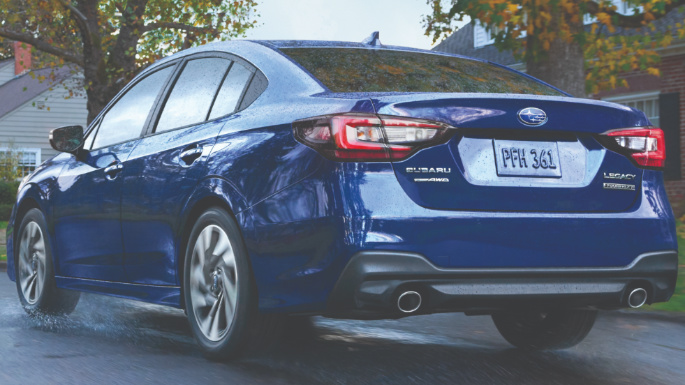
The engine size enumeration was dropped from its trim level naming convention, and with it, the flat-six option. A 2.5-liter boxer engine still served as the base powerplant, but was updated to produce 182 horsepower. In the 3.6-liter’s place was an optional 2.4-liter turbocharged flat-four engine that produced 260 horsepower and 277 lb-ft of torque.
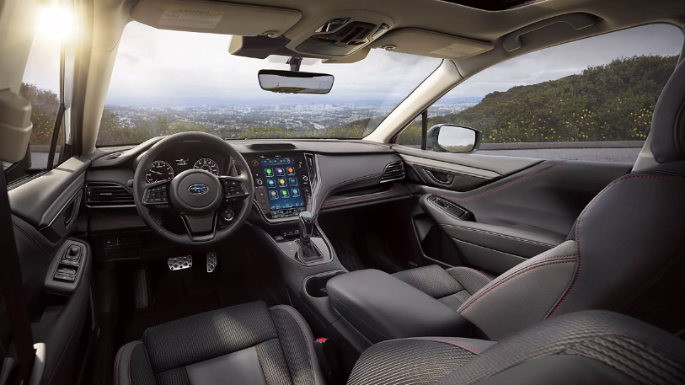
Fuel economy was improved on all fronts. Legacy models with the 2.5-liter engine saw 30 combined MPG, while 2.4-liter-powered Legacy models were not far behind with a combined estimate of 27 MPG. A CVT remained the only transmission choice across each of the Legacy’s six trim levels.
Base model Legacys came standard with a seven-inch touchscreen, Apple CarPlay, Android Auto, automatic climate control, LED headlights, and Subaru’s EyeSight safety system. Premium models added heated front seats, an 11.6-inch infotainment screen, alloy wheels, and dual-zone automatic climate control. Sport models largely followed the Premium’s equipment group but added sporty interior and exterior trim pieces, a lip spoiler, black wheels, and an auto-dimming rearview mirror.
Limited models served as the most luxurious in the lineup. They received adaptive headlights, leather upholstery, power-operated front seats, blind-spot monitoring, heated rear seats, and a Harman Kardon audio system. Limited XT models added the more powerful 2.4-liter turbocharged engine. Top-tier Touring XT trim levels received the larger engine plus ventilated front seats and higher-grade leather upholstery.
Adaptive headlights and a rear-seat alert system were added to the Legacy’s list of standard safety features in 2021. After minimal changes for 2022, 2023 models were treated to a mild refresh that enlarged the front grille, sharpened the headlights, and reshaped the front bumper. On top of that, Subaru’s EyeSight system was given some upgrades, including the addition of an automatic emergency steering.
The most significant update was given to the Sport trim. It received the 260-horsepower turbocharged engine from the XT trim as standard.
As the Legacy nameplate prepares for its departure, only a few features have been added here and there for the 2025 model year, including driver attention monitoring, a heated steering wheel, and a sunroof – all to the Limited trim.
2015 - 2019 Subaru Legacy (6th Generation)
The Legacy’s sixth generation started in 2015 with a redesign that was much more attractive and well-received than the previous version's. The 2.5i, 2.5i Premium, 2.5i Limited, and 3.6 R Limited trims all carried over from the 2014 model, but Subaru removed the manual transmission option. The sole transmission choice was a CVT, which boosted fuel economy.
The 2.5-liter flat four was carried over from the previous generation and made 173 horsepower and 174 lb-ft of torque. The 3.6-liter flat-six also continued to produce 256 horsepower. Even though the Legacy had become more focused on comfort rather than sportiness, both powertrains’ fuel economy estimates were improved.
Legacy models equipped with the smaller flat four returned 26 MPG in the city and 35 MPG on the highway, both impressive numbers for a vehicle with standard all-wheel drive. Models with the 3.6-liter engine returned lower estimates of 20 MPG in the city and 28 MPG on the highway.
In addition to an increased fuel economy, the Legacy became safer. The NHTSA gave the car a five-star overall crash test rating, and the IIHS was right along with them, giving the 2015 Legacy a Top Safety Pick+ award. Available safety features included automatic emergency braking, lane-departure warning, pedestrian detection, rear cross-traffic alert, and adaptive cruise control.
Standard features on the base 2.5i included a 6.2-inch infotainment touchscreen, Bluetooth, air conditioning, cruise control, a four-speaker audio system, automatic headlights, and Pandora streaming capability. 2.5i Premium models gained alloy wheels, dual-zone automatic climate control, heated front seats, a leather-wrapped steering wheel, and a larger seven-inch infotainment display.
Top-of-the-line 2.5i Limited models came with 18-inch alloy wheels, leather upholstery, heated rear seats, and a 12-speaker Harman Kardon audio system. Opting for the larger 3.6 engine netted buyers the same features as the 2.5i Limited trim with the addition of xenon headlights.
A handful of features were either added or updated for 2016, including steering and suspension tweaks, the addition of lane-departure mitigation to Subaru’s EyeSight safety system, and updates to its infotainment system. Reverse automatic emergency braking was added to EyeSight the following year alongside a new Legacy Sport trim that came with unique trim features.
The Legacy’s styling was sharpened for 2018 as part of a mid-cycle refresh. Subtle styling changes to the front and rear were accompanied by subtle changes throughout the rest of the car as well. Its interior was freshened, steering responses were sharpened, the CVT was updated to provide better responsiveness, and a larger 6.5-inch touchscreen became standard.
To round out the sixth generation’s final year of production, Subaru added its EyeSight safety suite as standard equipment across the entire lineup.
2010 - 2014 Subaru Legacy (5th Generation)
The fifth-generation Legacy arrivedin in 2010 and made a decisive leap toward more conventional sedan styling, leaving other Subaru models such as the Outback and the Forester to handle the more adventurous buyer’s needs. Its designers placed a greater emphasis on interior feel and comfort, increasing its cabin space to better compete with the likes of the Honda Accord, the Toyota Camry, the Ford Fusion, and the Nissan Altima.
Its wheelbase, width, and height were all increased by more than three inches. This resulted in 43 inches of front passenger legroom, 37.8 inches of rear passenger legroom, and nearly as much headroom in the back seats.
Trim levels were differentiated by powertrain options as well as features. The 2.5i, 2.5i Premium, and 2.5i Limited trims were fitted with a 2.5-liter boxer engine that produced 170 horsepower, while 2.5 GT Premium and 2.5 GT Limited models featured a turbocharged version of the same engine and produced 265 horsepower. The 3.6 R, 3.6 R Premium, and 3.6 R Limited models featured a 256-horsepower flat-six engine.
Both the naturally aspirated and turbocharged 2.5-liter-equipped Legacy models could be specified with a six-speed manual transmission. Alternatively, they came with a new Lineartronic continuously variable transmission in an effort to boost fuel economy. 3.6-liter-equipped models were fitted solely with a five-speed automatic transmission. Naturally, each came standard with all-wheel drive.
The Legacy’s standard features included ABS, stability control, traction control, side curtain airbags, air conditioning, a four-speaker audio system, a CD player, and an electronic parking brake. Premium trims received upgrades such as a leather-wrapped steering wheel, alloy wheels, and a power-operated driver’s seat. Limited trims were equipped with Bluetooth, leather upholstery, dual-zone automatic climate control, heated front seats, and a Harman Kardon audio system.
The 2.5 GT Premium was dropped from the lineup for the following model year, and a sunroof was added to the GT Limited’s standard features list. Subaru gave the 2013 Legacy a mild facelift with revised front headlights and a revised grille alongside several trim and powertrain changes.
Subaru dropped the GT trim altogether, also eliminating the 2.5-liter turbo engine. The standard 2.5-liter engine got a boost to 173 horsepower – three more than the previous model year’s powerplant. The Legacy’s CVT and suspension benefitted from some optimization and upgrades, making the car more fuel-efficient and responsive.
Bluetooth was added to each Legacy’s standard features list, and Subaru’s EyeSight safety system became optional. It featured advanced safety systems like adaptive cruise control, lane-departure warning, and automatic emergency braking.
For the final year of its fifth generation of production in 2014, Subaru dropped the standard 3.6 R trim from the lineup. Heated seats were also added to the 2.5i Premium’s list of standard equipment.
2005 - 2009 Subaru Legacy (4th Generation)
The fourth-generation Subaru Legacy, redesigned for the 2005 model year, took a much larger step forward than its predecessor. It featured sharper, sportier Japanese styling but with a powertrain and a tight chassis that were better able to compete with the best that Europe brought to the table. It also remained one of the few affordable new cars offered in both a sedan and a wagon body style.
The highlights of the new Legacy were multi-faceted. Headlining the changes was an updated set of trim levels and powertrains. Base 2.5i models served as the most affordable models in the lineup. They still came with a 2.5-liter boxer engine, but output was bumped to 168 horsepower. Still standard with a five-speed manual transmission, fuel economy was increased to a combined 23 MPG even if buyers opted to skip that and went for the four-speed auto.
2.5i Limited trims received the same powerplant. 2.5i GT and 2.5i GT Limited trims benefitted from a more powerful 2.5-liter turbocharged engine that borrowed its design from the Subaru Impreza WRX STi. It produced a healthy 250 horsepower and 250 lb-ft of torque, giving the Legacy the pep it had been lacking. Both manual and automatic transmission options were available.
Legacy models came standard with a limited-slip differential, child seat anchors, daytime running lights, four-wheel disc brakes, ABS, a six-speaker audio system, power windows, power mirrors, air conditioning, cruise control, 16-inch alloy wheels, and a host of airbags. Better-equipped models featured power-operated front seats, heated front seats, foglights, dual-zone climate control, a leather-wrapped steering wheel, leather upholstery, dual sunroofs, and 17-inch alloy wheels.
Subaru made several changes to the Legacy only a year after completely redesigning it in 2005. The 2.5 GT trim was dropped from the lineup, leaving the GT Limited in its wake. The non-turbo 2.5-liter engine got a boost to 175 horsepower as a consolation to Legacy buyers. GT Limited Legacy wagon models lost the standard manual transmission, but in its place was a five-speed automatic shared across the GT trim level spectrum.
Another big change was the introduction of the 2.5 GT Spec.B trim level to the lineup. It featured the 2.5-liter turbo, a five-speed manual transmission, a functional hood scoop, a Momo steering wheel, Bilstein shocks, and a sporty ground effects kit. The Spec.B was given a six-speed manual transmission and an upgraded limited-slip differential the following year.
Subaru gave the Legacy a mild facelift for the 2008 model year. With that, the Legacy touring wagon body style was removed from the lineup, leaving the wagon body style option solely within the Subaru Outback’s court. Despite the wagon’s departure, a new trim level was added to the Legacy lineup to keep its lineup diverse.
The Legacy 3.0 R Limited featured a 3.0-liter flat-six engine that produced 245 horsepower and 215 lb-ft of torque. It came exclusively with a five-speed automatic transmission that featured paddle shifters and rev-matching capability.
For the fourth generation Legacy’s final year of production, Subaru added standard stability control on each trim level except for manual transmission-equipped 2.5 GT models. Two additional trim levels were also added to the Legacy lineup. The 2.5i Special Edition served as a mid-level Legacy model with the standard engine. The 3.0 R trim came with the flat-six engine but also fewer features and a lower price tag than the 3.0 R Limited.
2000 - 2004 Subaru Legacy (3rd Generation)
The Legacy came back in 2004 with a complete redesign that looked more modern, sporty, and handsome than the preceding model. Although it still featured some familiar styling cues from the previous generation, its more aerodynamic shape helped each model earn a respectable 19 MPG in the city and 25 MPG on the highway, despite coming standard with full-time all-wheel drive.
Each 2000 model-year Legacy sedan and wagon came with a 2.5-liter flat-four engine that produced 165 horsepower and 166 lb-ft of torque. Each was also mated to a standard five-speed manual transmission with a four-speed automatic transmission serving as an alternative.
The Legacy retained its three trim levels from the previous model. Legacy wagon models were available in entry-level Brighton, mid-level L, and top-of-the-line GT trims. Legacy sedans came in L, GT, and GT Limited trims. Each came with features such as daytime running lights, ABS, front seatbelt pre-tensioners, and front-side airbags.
Outback models that had previously been included as part of the Legacy lineup were split off into their own model line. They were also available in sedan and wagon body styles, but both benefitted from extra ground clearance and a larger focus on treading the line between a road-going sedan and a crossover. Legacy models remained more focused on road manners, despite still featuring standard AWD like the other available Subaru models.
The Legacy Brighton wagon was eliminated from the lineup in 2001, leaving only the L and GT trims for Legacy wagon models. Base Legacy L models gained a temperature gauge and a digital odometer while GT models gained a power-operated sunroof, a limited-slip rear differential, and a power-operated driver’s seat. Sedan GT Limited models received heated front seats and a windshield wiper de-icer in 2002. Standard GT models received upgraded brakes.
Larger changes came to the Legacy lineup in 2003. The base L trim remained, but GT models were combined into a single Legacy 2.5 GT trim in both the sedan and wagon body styles. Additionally, a Special Edition L trim was added to the lineup that featured the standard equipment from the base model with a few 2.5 GT extras like a leather-wrapped steering wheel, a moonroof, and 16-inch alloy wheels.
The four-speed automatic transmission gained Sportshift manual mode capability, and the car’s exterior was lightly refreshed to cap off its mid-generational update. A 35th Anniversary package was offered on both the sedan and wagon for 2004 to close out its third generation of production.
1995 - 1999 Subaru Legacy (2nd Generation)
The second-generation Legacy arrived in 1995, marking the first year of major changes to the lineup since the its initial release. Its styling was much less boxy than before, becoming much sportier and aerodynamic. The 2.2-liter boxer engine was carried over from the previous generation, but the turbocharger was dropped, leaving only the 135-horsepower standard engine.
Front-wheel drive remained standard but only on a handful of the many trim levels. Base sedans, L wagons, and L Sedans were the only ones with the FWD drivetrain while the rest of the lineup benefitted from AWD.
L, LS, and LSi trim all carried over into the Legacy’s second generation of production. Brighton and Outback models were added to the lineup but were only available in the wagon body style. Each trim level came standard with the five-speed manual transmission from the year before except the LS and LSi trims which came standard with a four-speed automatic transmission.
The Brighton wagon served as the base model sedan’s counterpart. Its low sub-$18,000 MSRP was not much more expensive than the base sedan’s $16,500 MSRP, but it included standard features such as air conditioning, power windows, and a cassette player. The Outback wagon was pricier and catered to more outdoorsy buyers. It was introduced to better compete with the growing crop of SUVs and crossovers of the time, offering around seven inches of ground clearance.
Right after its redesign in 1995, Subaru turned around and made several welcome changes to the Legacy lineup. A new Legacy GT was added to the list of available trims. It featured a larger 2.5-liter flat four-cylinder engine that produced 155 horsepower. It came standard with the four-speed auto from the LS and LSi trims, and the powerplant itself was made standard on the LSi trim. The Legacy GT was available in both sedan and wagon body styles.
More changes were made in 1997, including the complete removal of the FWD drivetrain from the lineup. In addition to the drivetrain update, both the 2.2-liter and 2.5-liter engines gained some extra power. The smaller of the two produced 142 horsepower and the larger powerplant made 165 horsepower. The five-speed manual transmission, previously only available with 2.2-liter Legacy models, was made available with the 2.5-liter powerplant.
An Outback Limited model with luxury touches such as leather upholstery, alloy wheels, and wood grain interior trim was added to the lineup. Legacy GT models received a styling refresh and sporty touches like larger tires.
There were plenty of changes in 1998, including the dropping of the LSi trim, the addition of a Legacy GT Limited trim to the lineup, and the addition of a dual-moonroof option for the Legacy Outback. 30th Anniversary models were made available on each Limited trim model plus the base sedan for 1998 along with the addition of keyless entry across the board.
1990 - 1994 Subaru Legacy (1st Generation)
The Subaru Legacy was first introduced in 1989. Even though it was built to compete within the North American market, it went on sale in Japan in 1989, one year before it hit the European, Australian, and UK markets.
A four-door sedan or a 'touring wagon' were available in one of three trim levels. Base sedans and wagons featured front-wheel drive. L and LS sedans and wagons both came standard with front-wheel drive but could be upgraded to full-time all-wheel drive. Each Legacy model came standard with a 2.2-liter flat-four cylinder boxer engine that produced 130 horsepower and 137 lb-ft of torque. A five-speed manual transmission was also standard.
Both sedan and wagon body styles came with a 101.6-inch wheelbase, motorized seat belts, and optional anti-lock brakes.
LSi and Sport Turbo trim levels were made available in 1991. LSi models came with a four-speed automatic transmission rather than a five-speed manual and were only available with the sedan. They retained the 2.2-liter engine from the rest of the lineup. Legacy Sport Turbo models also came exclusively in the sedan body style but featured a turbocharger that boosted engine output to 160 horsepower.
A standard driver airbag was added to LS and LSi Legacy models in 1992, one year before it was standardised across the entire lineup. ABS also became standard on all but the base model for 1993. A Touring Turbo wagon trim level was added to the lineup in 1993 to complement the Sport Turbo sedan, and the LSi trim level was made available with the wagon body style. Finally, the LSi trim level came standard with AWD.
